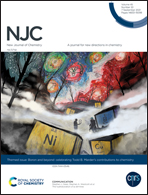Stability and decomposition of copper(i) boryl complexes: [(IDipp)Cu–Bneop], [(IDipp*)Cu–Bneop] and copper clusters†‡
Abstract
The NHC copper boryl complexes [(IDipp)Cu–Bneop] (2) and [(IDipp*)Cu–Bneop] (3) (IDipp = 1,3-bis(2,6-diisopropylphenyl)imidazol-2-ylidene, IDipp* = 1,3-bis(2,6-(diphenylmethyl)-4-methylphenyl)imidazol-2-ylidene, neop = (OCH2)2CMe2) were synthesised and fully characterised including single crystal X-ray structure determinations. The comparably rapid decomposition of 2, as reported previously by Sadighi and co-workers, was corroborated and can be attributed to the properties of the Bneop ligand in combination with the steric properties of the IDipp ligand. The decomposition of 2 leads predominantly to the free NHC, the diborane(4) B2neop2 (1) and, presumably, elemental copper. Minor products of this reductive decomposition are the unprecedented low-valent copper clusters [(IDipp)6Cu55] and [(IDipp)12Cu179] that were characterised by single crystal X-ray structure determinations. It is concluded that an insight in the decomposition pathways and products of copper boryl complexes is essential for the understanding of copper boryl complexes and therefor for the further development of the flourishing field of copper mediated borylation reactions.
![Graphical abstract: Stability and decomposition of copper(i) boryl complexes: [(IDipp)Cu–Bneop], [(IDipp*)Cu–Bneop] and copper clusters](/en/Image/Get?imageInfo.ImageType=GA&imageInfo.ImageIdentifier.ManuscriptID=D0NJ03166F&imageInfo.ImageIdentifier.Year=2021)
- This article is part of the themed collection: Boron & Beyond - in celebration of Todd Marder


 Please wait while we load your content...
Please wait while we load your content...